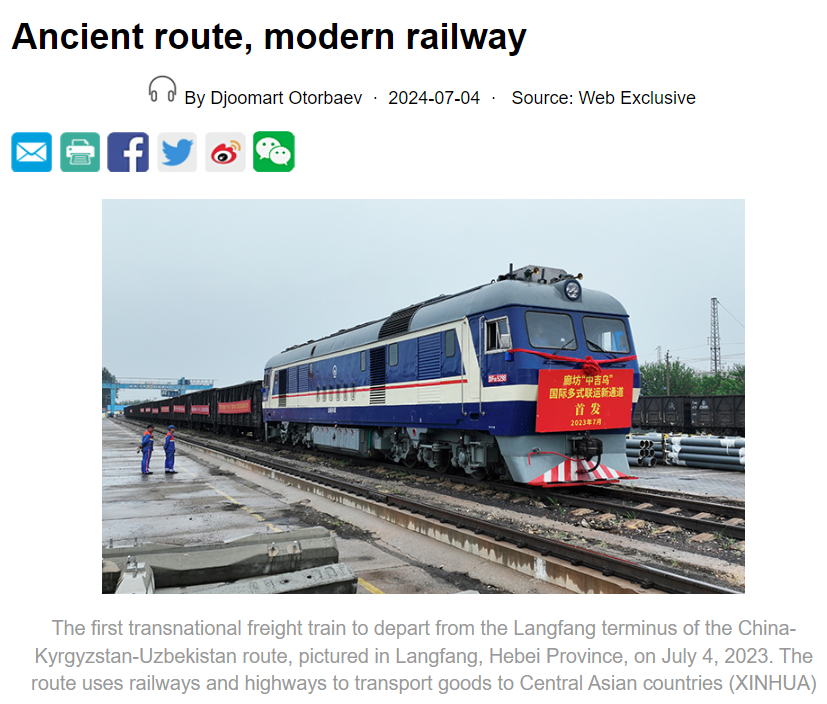LATEST INSIGHTS
Your Present Location: LATEST INSIGHTSDjoomart Otorbaev: Ancient route, modern railway
Source: Beijing Review Published: 2024-07-02

The countdown for a major Eurasian transport project has begun.
In the early 1990s, the newly independent Central Asian republics demonstrated strategic foresight when they initiated discussions about constructing new transport routes with their powerful neighbor, China. This visionary approach, coupled with China's growing economic power, led to the construction of several highways, including two which connected China and Kyrgyzstan, passing through the border crossings of Torugart and Irkeshtam. Now a vital part of the region's infrastructure, these routes have greatly improved transport links and trade relations between the two neighbors.
The construction of these highways has proven to be a significant boon for both countries. What began as a modest trade relationship in the early 1990s has blossomed into an annual trade volume of $118 million in the early 2000s. This figure surged to an impressive $5.2 billion in 2009, surpassing Kyrgyzstan's GDP of $4.69 billion in the same year. In 2023, mutual trade turnover between Kyrgyzstan and China reached $19.8 billion, according to Kyrgyz statistics.
New initiative
In the mid-1990s, with increasing economic development and trade, the parties involved began to discuss building a railway. The initial agreement to build the China-Kyrgyzstan-Uzbekistan (CKU) Railway was signed in 1997. Officially announced in 1999, this transport initiative was vital to China's larger strategy of developing its western regions. It aimed to transport resources from China's western territories to its economic centers on the east coast. With its rich energy and mineral resources, Central Asia was also considered a promising region for cooperation as China sought to revive the ancient Silk Road. In the long term, it aimed to establish trade routes connecting China with Europe and the Middle East.
In the 2000s, several crucial Chinese energy and infrastructure projects were established in Central Asia. The Chinese gas pipelines from Turkmenistan were completed in 2009 and the oil pipeline from Kazakhstan became operational in 2010. The CKU Railway, a vital component of this strategy, was envisioned as a game-changer in the region's transportation strategy. At that time, the estimated cost of the railway was $2 billion. Since the early 2000s, both China and Kyrgyzstan have conducted several pre-feasibility studies for the construction of the CKU Railway. These studies, backed by international organizations such as the European Union and the World Bank, have assisted, underscoring the global importance of this project.
Since 2017, Uzbekistan has also played a significant role in promoting the building of a railway. In 2017, Uzbekistan sent railway experts to Kyrgyzstan to discuss the CKU. Then, in 2019, Uzbekistan invited Turkey to jointly support the Kyrgyz section of the railway.
The rapidly increasing rail freight between China and Europe primarily drove the speedy completion of negotiations for constructing the CKU Railway. From 2011 when trade commenced along the rail route to May 2024, over 8.7 million twenty-foot equivalent units of containers were transported between the Eurasian continent's two major economic powers, carrying goods worth more than $380 billion. Now, these freight trains link 223 cities in 25 European countries and over 100 cities in 11 Asian countries. If the CKU Railway is completed, it will reduce the distance between China and Europe by 900 km, making it the shortest route. A simple analysis of the presented figures convinced everyone that the project was economically feasible.
Implementation
After the end of the COVID-19 pandemic, negotiations between the parties entered a final phase. Since 2022, the countries' presidents have met repeatedly in different settings. At all meetings, the issue of the construction of the CKU railway was always on the agenda.
The final CKU project implementation agreement was signed on June 6 in Beijing. This marked the culmination of a project under discussion for over 25 years. The decision was made to construct a railway along the Kashgar--Torugart--Makmal--Jalal-Abad--Andijan route. The three countries created a joint project company (JPC) with headquarters in Bishkek to facilitate the project. According to the agreement, China Railway International owns 51 percent of the company, while Kyrgyzstan and Uzbekistan national railway operators own 24.5 percent each. The construction will follow the BOT (build-operate-transfer) principle.
The preliminary construction cost in the territory of Kyrgyzstan is estimated at $4.7 billion, with China providing half of this amount as a loan to the JPC. The parties will invest the remaining amount in proportion to their shares in the joint venture's capital. It was announced that the terms and interest rate of the loan would be determined later.
Kyrgyzstan will be responsible for land acquisition, demolition and resettlement of land plots. It provides conditions for construction, the use of local building materials, electricity and water supplies, exempts Chinese and Uzbek personnel from obtaining work permits, and exempts imported goods needed for the project from taxes and customs duties. The Chinese side will be responsible for design, procurement, construction and other major work. Also, China will construct a section of railway on Chinese territory connecting to a section of the railway in Kyrgyzstan.
Thus, construction of a significant Eurasian transportation project has commenced. It is scheduled to start in October and conclude within six years. This route will ensure the delivery of goods between China, the countries of Central Asia, the South Caucasus, Iran, Turkey and Europe. By reducing the distance and time of cargo delivery, the project will ensure increased competitiveness of all participating countries in the international transport market. After its completion, the world will witness the revival of the new Great Silk Road.























































































 京公网安备 11010802037854号
京公网安备 11010802037854号





